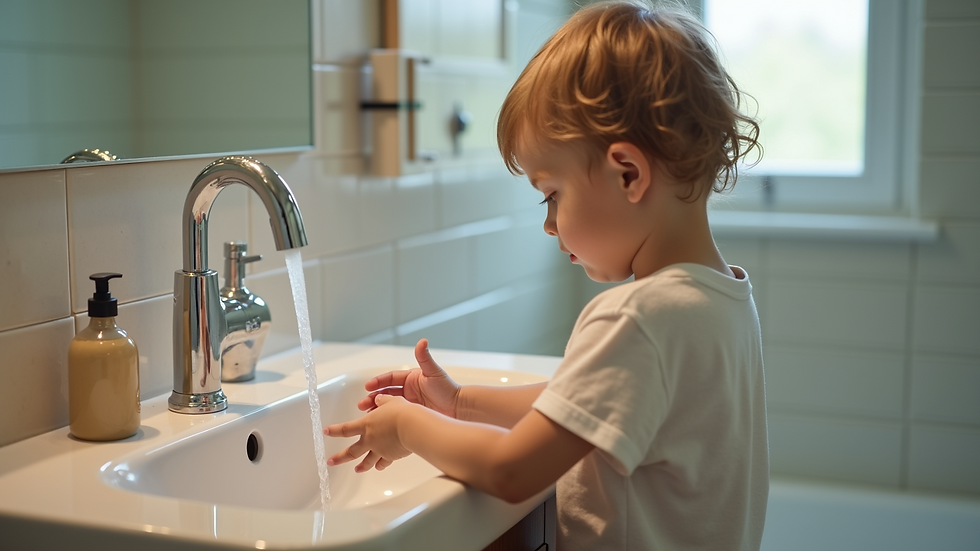Can Pets Transfer Pinworms to Children and How to Prevent It
- Arsalan Nazar
- Oct 3
- 4 min read
Pinworms are a common concern for parents worried about their children's health. These tiny parasites can cause discomfort, leading many to ask whether pets can transfer pinworms to kids. In this post, we will examine this issue closely, exploring how pinworms spread, their symptoms, and effective prevention strategies.
Understanding Pinworms
Pinworms, scientifically known as Enterobius vermicularis, are small, white, thread-like worms that primarily inhabit the intestines of humans. They are most commonly found in children aged 5 to 10 years, but adults can also be affected. The primary mode of transmission occurs through the ingestion of pinworm eggs, which can be present on contaminated surfaces, clothing, or bedding.
While pinworms do not pose serious health risks, they can lead to significant discomfort. Common issues include:
Intense itching around the anus
Irritability
Difficulty sleeping
According to the Centers for Disease Control and Prevention (CDC), pinworms affect about 40 million people in the United States, with children being particularly susceptible due to their habits of touching surfaces and then putting their hands in their mouths.
Can Humans Get Pinworms from Pets?
The straightforward answer is no; humans cannot get pinworms from pets. Pinworms are a human-specific parasite, which means they only infect humans. Dogs and cats can carry other types of worms and parasites, such as roundworms and tapeworms, but not pinworms.
However, pets can contribute to overall hygiene in the household. For example, a pet with fleas may increase the likelihood of other health issues in children. A study showed that households with pets had a 30% higher chance of experiencing parasitic infections due to the various pathogens pets can host.
How Do Pinworms Spread?
Pinworms spread primarily through the fecal-oral route. Here’s a breakdown of how this typically happens:
Eggs on Surfaces: Pinworm eggs can settle on surfaces like bedding, clothing, and toys. When a child touches these contaminated surfaces and then brings their hands to their mouth, they ingest the eggs.
Inhalation: Sometimes, eggs can become airborne. Inhaling these eggs can lead to infection.
Direct Contact: If a child scratches their anal area and then touches their food or mouth, they transfer the eggs.
Contaminated Food or Water: While less common, pinworm eggs can sometimes contaminate food or water.
Understanding these transmission methods is key for parents to develop effective prevention strategies.
Symptoms of Pinworm Infection
Recognizing the symptoms of a pinworm infection is crucial for prompt treatment. Common symptoms include:
Itching: The most noticeable symptom is intense itching around the anus, particularly at night.
Restlessness: Children may become irritable or restless due to discomfort related to the itching.
Sleep Disturbances: The itching can disrupt sleep, leading to fatigue during the day.
Secondary Infections: Intense scratching can result in bacterial infections.
A study found that 90% of children with pinworm infestations experienced disrupted sleep. If you suspect your child has pinworms, consult a healthcare professional for diagnosis and treatment.
Prevention Strategies
Preventing pinworm infections revolves around maintaining good hygiene. Here are some effective strategies:
Regular Handwashing
Teach children to wash their hands frequently, especially after using the bathroom and before they eat. Use soap and water, scrubbing for at least 20 seconds.
Keep Fingernails Short
Keeping children’s fingernails trimmed can reduce the chance of eggs getting lodged under the nails, where they can be ingested later.
Daily Bathing
Daily bathing can remove eggs from the skin. Make sure to clean the anal area thoroughly.
Wash Bedding and Clothing
Regularly wash bedding, pajamas, and clothing in hot water to kill any pinworm eggs. This is particularly important if someone in the household has been diagnosed with a pinworm infection.
Avoid Sharing Personal Items
Remind children not to share personal items such as towels or bedding, which can facilitate the spread of pinworm eggs.
What to Do If Your Child Has Pinworms
If you suspect that your child has pinworms, it's crucial to act quickly. Here’s what to do:
Consult a Healthcare Professional: A doctor can confirm the diagnosis and prescribe appropriate treatment, typically over-the-counter or prescription medication.
Treat the Entire Household: Since pinworms can spread easily, it is advisable to treat all family members, even if they do not show symptoms.
Reinforce Hygiene Practices: After treatment, continue to emphasize good hygiene to help prevent reinfection.
Monitor Symptoms: Keep an eye on your child’s symptoms. Consult a doctor if they persist or worsen.
Are Pinworms Dangerous?
While pinworms can cause irritation and discomfort, they are not life-threatening. The main concern centers on quality of life and the risk of secondary infections from scratching. In rare cases, complications can occur, but these instances are uncommon. Promptly addressing pinworm infections is crucial to avoid complications and maintain your child's well-being.
The Role of Pets in Household Hygiene
Although pets do not transmit pinworms, they can affect household hygiene. Here are some considerations:
Regular Vet Check-ups: Ensure pets receive regular veterinary care for routine parasite testing.
Clean Pet Areas: Regularly clean areas where pets sleep and play to minimize the risk of other infections.
Teach Children About Pet Hygiene: Educate children about the importance of washing their hands after playing with pets.
Final Thoughts
While pets cannot transfer pinworms to children, upholding good hygiene is essential for preventing infections. Recognizing how pinworms spread and understanding their symptoms allows parents to take effective preventive measures.
By keeping a clean environment and stressing hygiene habits, families can significantly reduce the risk of pinworm infections. This proactive approach ensures that children remain comfortable and healthy.

Stay informed and take action to promote a healthy home environment for your family.




Comments